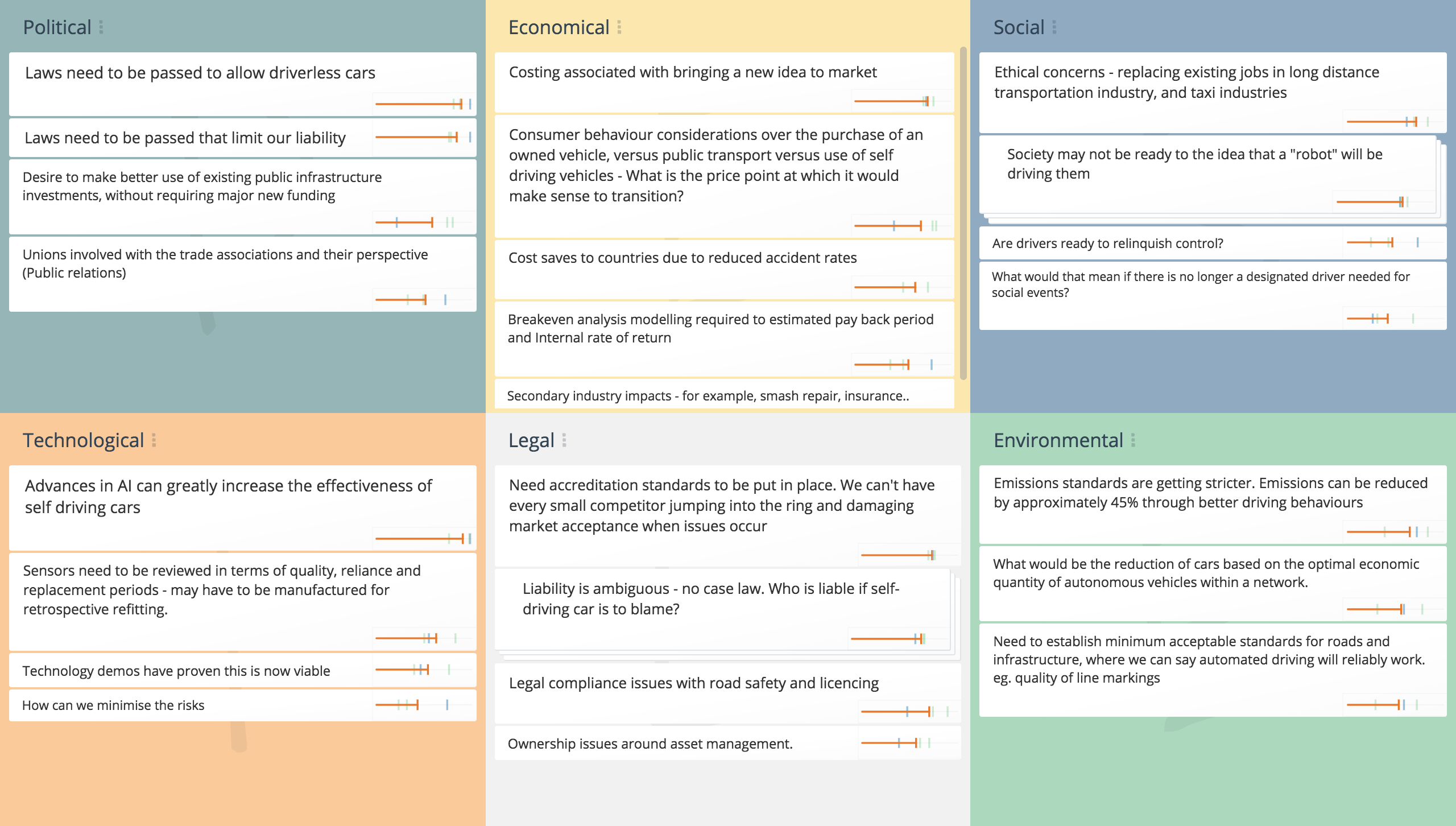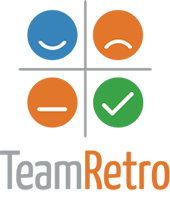
What is PESTLE Analysis?
A PESTLE analysis is an extension of the PEST model used for environmental scanning and includes the elements of Political, Economical, Social, Technological, Legal and Environmental factors that could have a direct or long lasting impact on the organization.
This method is used as part of a strategic planning or risk management process and provides an oversight to the team about what is current in their environment and what should be considered in light of these factors.
The output from a PESTLE analysis is often used as an input for other business management tools such as SWOT analysis, SOAR analysis, risk assessment, or a Business Model Canvas.
There are many variations of this framework, which examine different combinations of external factors, specific to particular industries. Examples include: PEST, STEEPLE, STEER and STEEP.
Why Do a PESTLE Analysis?
A PESTLE analysis helps a team to understand the organization’s market and business position better, plan strategically, and conduct market research in new and existing markets. The framework:
- Encourages strategic thinking and helps you evaluate how your strategy fits into the broader environment
- Provides an overview of the crucial external influences on the organization
- Allows leaders to make more decisive and knowledgeable decisions
Who is Involved in a PESTLE Analysis?
A PESTLE analysis is useful in all industries at the strategic, departmental, and project level to assess current and future markets. Use it as a key input for planning, marketing, organizational change, business and product development, project management, and research reports.
Generally speaking, PESTLE’s are conducted as part of the organisations strategic planning process and is used to help shape the future direction. Senior Managers, C-Level executive, Leaders, major stakeholders, partners, consultants and even major clients all make the invite list when it comes to a PESTLE analysis.
- Carefully select participants to provide expert knowledge but also a fresh perspective.
- A PESTLE analysis is not just about listing down political, economic, social and technological factors that you simply know or have heard of. It is also important to validate them with suitable information and rate its impact on your organization.
- Rating the impact of each factor lets you identify the most important issues.
- For complex organisations and where they are servicing multiple locations, there may need to be a PESTLE analysis for each environment.
- Use quantitative data where possible to focus on the crux of the issue.
- Provide adequate time in the session to rank and prioritize ideas.
- You can also have people vote or colour code factors that are temporary, long term or should be monitored over time.
- Try to keep factors relatively high level and avoid getting bogged down in analysis paralysis.
- Aguilar, Francis. 1967. “Scanning the Business Environment.” New York: The Macmillan Company. p239.
- Chartered Management Institute – Carrying out a PEST Analysis Checklist
PESTLE Template
Political
Examples include:
Government policy, political stability or instability, bureaucracy, corruption, foreign trade policy, tax policy, trade restrictions, labor/environmental/copyright/consumer protection laws, competition regulation, funding grants & initiatives, etc.
Questions to ask:
- What government policies or political groups could be beneficial or detrimental to our success?
- Is the political environment stable or likely to change?
Economic
Examples include:
Economic trends, growth rates, industry growth, seasonal factors, taxation, inflation, interest rates, international exchange rates, International trade, labor costs, consumer disposable income, unemployment rates, availability of credit, monetary policies, raw material costs, etc.
Questions to ask:
- What economic factors will impact on us moving forward?
- Does the current economic performance affect us?
- How does each economic factor impact our pricing, revenues, and costs?
Social
Examples include:
Attitudes and shared beliefs about a range of factors including health, work, leisure, money, customer service, imports, religion, cultural taboos, the environment; population growth and demographics, family size/structure, immigration/emigration, lifestyle trends, etc.
Questions to ask
- How do our consumer’s values and beliefs impact on their buying habits?
- How does human behavior or cultural trends play a role in our business?
Technological
Examples include:
Technology and communications infrastructure, consumer access to technology, emerging technologies, automation, legislation around technology, research and innovation, intellectual property regulation, competitor technology and development, technology incentives, etc.
Questions to ask:
- What innovations and technological advancements are available or on the horizon?
- How might they affect our operations?
Legal
Examples include:
Laws regarding consumer protection, labor, health & safety, antitrust, intellectual property, data protection, tax and discrimination; international and domestic trade regulations/restrictions, advertising standards, product labeling and safety standards, etc.
Questions to ask:
- What regulations and laws apply to our business?
- Do they help or hinder our business?
- Do we understand the laws across all our markets?
Environmental
Examples include:
Weather, climate change, your carbon footprint, environmental regulations, pollution laws and targets, recycling and waste management policies, endangered species, support for renewable energy, etc.
Questions to ask:
- How does our physical environment affect us and vice versa?
- What are the effects of climate, weather or geographical location?
- Are we prepared for future environmental targets?
How to Do a PESTLE Analysis
While you can analyze the factors in the PESTLE template against the current status, you should also consider how potential changes might impact on your future.
Different industries may place more significance on one or more of the areas. For example, there is likely to be a very different emphasis for businesses involved in tourism, compared with those in the health, information technology, mining, banking, and defense industries.
The framework is most useful when you get input from participants with a range of different perspectives. Getting everyone together at the same time may be difficult in large or geographically dispersed teams. Video conferencing, online documents, and collaborative brainstorming tools such as GroupMap can solve many of these difficulties.

Brainstorm
Brainstorm ideas for each area of the PESTLE template.

Group
Review responses, and collate ideas.

Rate
Rate the ideas according to likely impact on the organization.

Share
Share the outcomes of the session to relevant stakeholders.
Gather ideas around the six PESTLE factors – Political, Economic, Social, Technological, Legal and Environmental. You can perform the initial brainstorming with the whole group or break out as smaller teams and then combine the ideas to get an overview.
Online collaboration software tools like GroupMap have an advantage over traditional brainstorming tools such as a whiteboard or post-it notes, as they significantly reduce the time and effort to combine independent lists, and make organizing and prioritizing the information much quicker and easier.
Once you have everybody’s ideas, group those that are similar and cull duplicates.
This step is more time consuming if the brainstorming was performed individually – or completed at different times and locations. Using a software tool like GroupMap to group ideas can significantly reduce the time and effort required in this step – and result in a better outcome.
Individually rate each of the ideas based on the level of impact you think they will have on your business.
Discuss any significant discrepancies in the ratings. Ask participants to explain their rationale and ideally, have them re-rate that idea based on discussions. The more aligned you can get people’s thinking around each factor, the better understanding everyone will have about challenges facing other parts of the organization, and the more focused your strategic planning will be.
The completed template gives a good overview of the status of the business. Distribute the PESTLE Analysis to relevant stakeholders. Use the report to monitor progress and as a foundation for future reviews.
Repeat the PESTLE analysis at regular intervals to stay on top of changes in the macro environment and keep your strategies and plans up to date.
GroupMap automatically generates visually appealing reports and action plans in several formats for distribution, saving time and effort after the analysis.

Save Effort, Time and Money with GroupMap
GroupMap offers more than just an online digital whiteboard—it’s innovative platform is designed to enhance the quality of your team’s decisions. With features that prevent bias and make facilitation seamless, GroupMap ensures no single voice dominates and ensures productive, inclusive conversations.
Its intuitive interface is easy for anyone to use, and its scalable design supports small teams and large groups whether they are face to face or around the globe. Customisable templates and workflows keep discussions focused on objectives, helping you drive actionable outcomes each and every time.
Create your first map and invite people in to start sharing their thoughts NOW.
Experience the power of GroupMap with our FREE 14 day trial.
Your free trial gives you access to all of our features, no credit card required.
